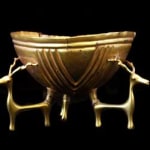Scythian Gilt Bowl Supported by Three Stags, 900 BCE - 600 CE
Gilt Metal
2.625
PF.0344
Further images
Scythians was the name used by ancient Greek writers to describe the various nomadic tribes of southeastern Europe and Asia who dwelled north of the Black Sea, between the Carpathian...
Scythians was the name used by ancient Greek writers to describe the various nomadic tribes of southeastern Europe and Asia who dwelled north of the Black Sea, between the Carpathian Mountains and the Don River, in what is now Moldova, Ukraine, and western Russia. The name was also more generally applied to all the nomad tribes who inhabited the steppes eastward from what is now Hungary to the mountains of Turkistan. Scythians kept herds of horses, cattle, and sheep, lived in tent-covered wagons, and fought with bows and arrows on horseback. They developed a rich culture characterized by opulent tombs, fine metalwork, and a brilliant art style.
The ancient artist has tamed the noble grace of the stag to support a vessel of delicate beauty. The animals reflect an appreciation for the natural world that is characteristic of the outer borders of the Near East. Its radiant form--which probably held a ritual offering--was treasured by the age that created it. Time has enhanced that loveliness with the patina of rarity, which makes it even more special to our own age.
The ancient artist has tamed the noble grace of the stag to support a vessel of delicate beauty. The animals reflect an appreciation for the natural world that is characteristic of the outer borders of the Near East. Its radiant form--which probably held a ritual offering--was treasured by the age that created it. Time has enhanced that loveliness with the patina of rarity, which makes it even more special to our own age.





